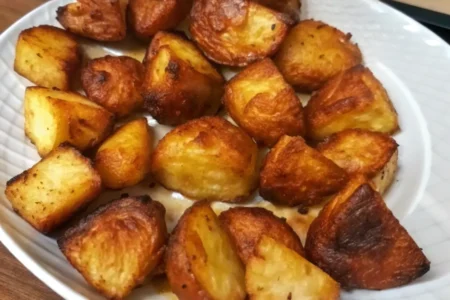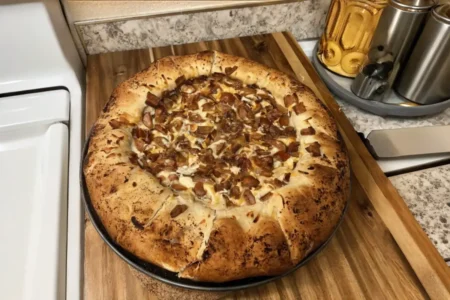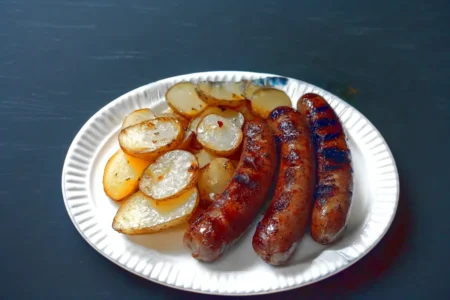A Ham, a Lime, and the Start of Something Magical
I still remember that wrinkly lime sitting at the back of the fridge, too dry for juice but perfect for scrubbing down a Glazed Ham. That’s how holiday meals started in my kitchen—scented with citrus, echoing with soca music, and filled with laughter over whose job it was to stick the cloves in “just right.” Whether it was Christmas morning in Trinidad or Thanksgiving with friends in Toronto, ham was always the hero, and the secret wasn’t just the ingredients—it was the ritual.
This recipe? It’s more than instructions—it’s a story. It’s Caribbean tradition brushed with brown sugar and broiled to a glossy, crackly crust. And no, it’s not just about flavor. It’s about that sigh of joy when the first slice falls onto your plate, glistening and juicy, surrounded by pineapple rings like little sun halos.
What You’ll Need (Spoiler: It’s Not Just a Ham)
The basics? A smoked bone-in fully cooked ham, cloves, brown sugar, honey, mustard, ground cinnamon, and if you’re feeling festive, some pineapple slices and maraschino cherries for garnish.
But it’s not just what you use—it’s how you use it. Don’t skip on using a narrow roasting pan—that’s how you keep all those glorious juices from evaporating into nothing. A shallow pan keeps it steamy and bastable (yes, that’s a word here). And trust me, get out your paring knife, measuring spoons, and a baster or large spoon, because this recipe is as hands-on as it gets.
The Old Lime Trick and Why I Don’t Boil My Ham
Let’s clear the air: I don’t boil my ham. Never have, never will. Growing up in Trinidad, maybe. But in New York? The ham isn’t salty enough to need it.
Instead, I wash it. Not with water—with lime. Scrubbing the surface with a cut lime is my pre-game ritual. It’s not just about cleaning. It lifts the funk and starts layering in that citrusy freshness.
And if your ham is extra salty? Boil it, sure. Or follow the package. But for me, that lime rub? That’s tradition in action.
Scoring, Cloving, and Making It Meditative
Here’s where the real fun starts. You grab your paring knife and start slicing the ham surface in diagonal lines to create a diamond pattern. Why? Because the glaze needs grooves to nestle into. And those cloves—sharp little bursts of flavor—go into every corner.
I like to go heavy—about 100 cloves for a 7-pound ham. It might sound like overkill, but the warm spice they give? It screams holidays. Bonus: It’s a great job for kids or impatient dinner guests. One little neighbor of mine used to “earn” his slice by inserting cloves. Bribery? Maybe. But it worked.
Glaze Before or After? Here’s the Twist
Most recipes tell you to glaze before baking. I used to. But one year, the glaze slipped right off and pooled sadly at the bottom. Since then? I bake the ham first—no glaze. Then I crank up the broiler, paint it with glaze, and watch the sugar crust form like caramel magic.
This method? It’s not just prettier. It’s tastier. The top crisps. The inside stays juicy. The edges get that irresistible sticky-chewy bite. Honestly, it’s almost candy.
Mixing the Magic Glaze
In a bowl, stir together:
- 1 cup brown sugar
- 1/4 cup honey (use more if you love it runny)
- 2 tablespoons Dijon or yellow mustard
- 1/2 teaspoon cinnamon (optional, but amazing)
Want heat? Toss in some cayenne or scotch bonnet if you dare. Or skip the cloves on the ham and mix some ground clove into the glaze instead for a more subtle hit.
And yes—taste it. That’s part of the fun.
A Caribbean Holiday Without Pineapple?
Couldn’t be me. Pineapple rings add sweet-tart juiciness and look like little golden halos. Stick a cherry in the center (I know, not everyone’s jam), and you’ve got the holiday vibe dialed in. Use toothpicks to attach them, or just place them at the bottom to flavor the glaze as it cooks.
And the glaze? I use my hands to spread it. Get messy. Own it. Food this good doesn’t stay neat for long.
Broil, Baste, Repeat
Once the ham is baked, glazed, and broiled, you’ll see that gorgeous crust form on top. The sauce bubbling at the bottom? Gold. Baste the ham every 10 to 15 minutes to deepen the layers of flavor. It’s like giving your ham a little facial.
After about 10 more minutes under the broiler, you’ll start to see magic—that deep, sticky brown crust, glistening with sugar and spice.
Here’s the trick: don’t panic if the edges look dark. You want that. That’s where the flavor lives.
Slice It Thin, Like Nana Did
I was taught to slice the ham paper-thin—part tradition, part thrift. But it does make the ham feel silkier. More refined. And when you pour that leftover glaze on top after slicing? Oh, honey.
You want to eat it standing over the counter with your fingers, whispering, “Just one more sliver…”
Ham Trivia That’ll Make You Smile
- Why cloves? Ancient Greeks used them to freshen breath. Caribbean aunties use them to flavor pork. Both were right.
- Pineapple on ham first showed up in 1950s American cookbooks. A mid-century marvel that stuck.
- Broiling for glaze isn’t traditional Caribbean, but it’s the kind of upgrade Grandma would’ve embraced after one taste.
3 Mistakes to Avoid
1. Using a wide pan: All your juices will dry up, and your glaze won’t get that lush, sticky finish.
2. Forgetting to preheat the oven: Sounds basic, but cold starts = uneven cooking and sad ham.
3. Skipping the baste: Basting is love. Basting is what turns brown sugar into magic.
5 Ways to Serve Glazed Ham
- With Coconut Rice – because sweet + savory is always a win.
- In Hawaiian Rolls – tiny ham sliders, perfect for holiday grazing.
- Over Creamy Grits – Southern meets Caribbean, and it works.
- With Fried Plantains – if you know, you know.
- Next to a Green Salad – for balance (or at least the illusion of it).
A Few Final Notes, Straight from the Oven
If your oven runs hot in the back (like mine), turn the ham halfway through broiling. Know your oven. Love your oven. Trust your nose.
And if your glaze ever feels too thick or sticky to spread? Warm it up or add a splash of pineapple juice. It’ll melt into the ham like it was meant to be there all along.
And when it’s finally done—dark brown, crisped at the edges, and sweet from the cloves and sugar—let it rest. Then slice it, pour those juices back over the top, and listen to the quiet hum of satisfaction around the table.
Holiday Ham, Caribbean Soul
This isn’t just about food. It’s about rhythm. About doing things a little slower, a little messier, and with way more love. Caribbean glazed ham is a dish that holds memories in every bite—from the cloves pressed in by little hands to the last slick of glaze wiped from the platter with a piece of bread.
Serve it with love, and it won’t matter what’s on the side. This ham is the main character.
Happy holidays, from my kitchen to yours.
Print
Caribbean-Style Glazed Ham That’s Juicy, Crispy, and Unforgettable
A holiday favorite with a Caribbean twist, this glazed ham recipe delivers crispy edges, juicy slices, and sweet-spiced flavor in every bite. Perfect for Christmas, Thanksgiving, or any family feast.
- Total Time: ~1 hour 50 minutes
- Yield: Serves 8–10 1x
Ingredients
-
5 to 9 lb smoked bone-in fully cooked ham
-
Fresh cloves (not older than 1 year)
-
1 cup brown sugar (demerara, turbinado, or raw)
-
1/4 cup honey
-
2 tbsp Dijon or yellow mustard
-
1/2 tsp ground cinnamon (optional)
-
Pineapple slices (fresh or canned)
-
Maraschino cherries (optional)
-
Lime (for scrubbing)
-
Toothpicks (for garnish)
Instructions
-
Scrub ham with cut lime to freshen and clean the surface.
-
Score ham in a diamond pattern, inserting cloves into each corner.
-
Preheat oven to 350°F. Place ham cut side down in a narrow baking pan lined with parchment.
-
Bake 10 minutes per pound without glaze.
-
Meanwhile, mix brown sugar, honey, mustard, and cinnamon to make the glaze.
-
Optional: add chili powder or ground cloves for extra kick.
-
Remove ham, secure pineapple and cherries with toothpicks.
-
Brush glaze generously over the ham (use your hands or a spoon).
-
Switch oven to broil. Return ham to oven and broil for 7–10 minutes, basting frequently.
-
Rotate ham if needed for even caramelization.
-
Remove from oven once a deep golden-brown crust forms. Let cool slightly.
-
Slice thinly and drizzle with pan juices before serving.
Notes
-
If ham is very salty, boil first as per packaging.
-
Glaze can be thinned with pineapple juice or gently heated.
-
Leftover glaze at the bottom of the pan is perfect for basting or drizzling.
- Prep Time: 20 minutes
- Cook Time: ~1.5 hours (varies by ham weight)
- Cuisine: Caribbean-American Fusion






